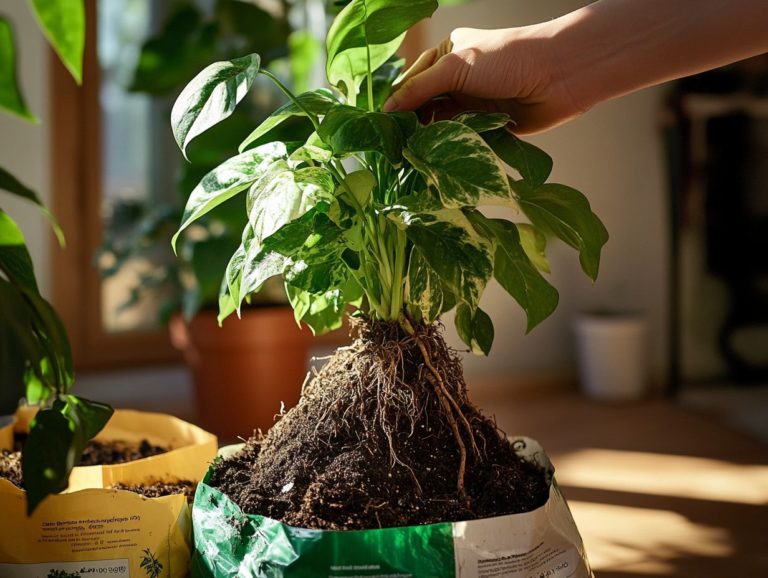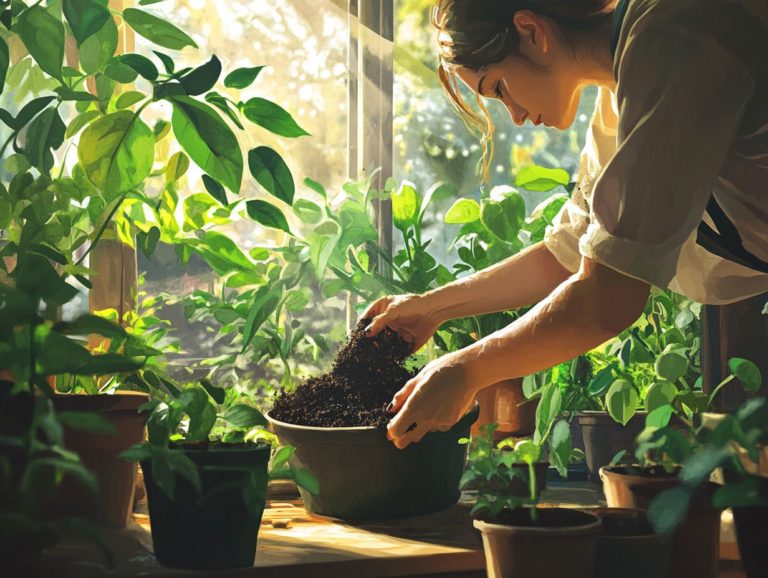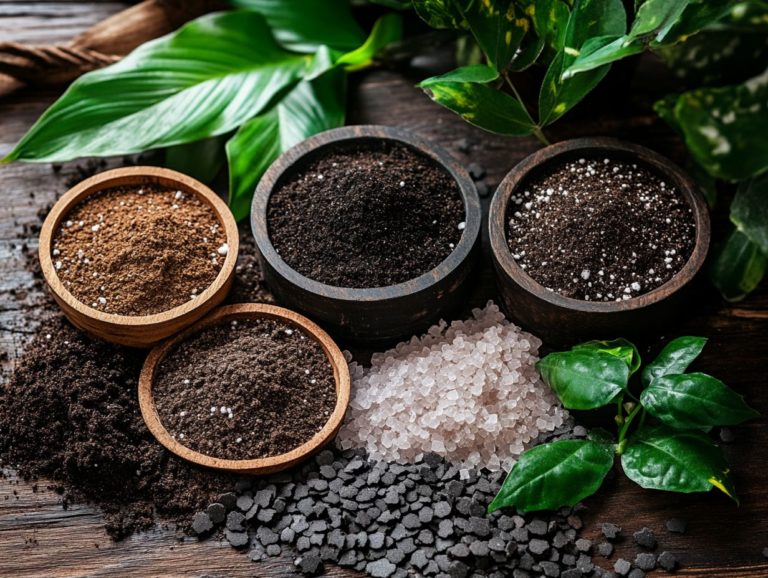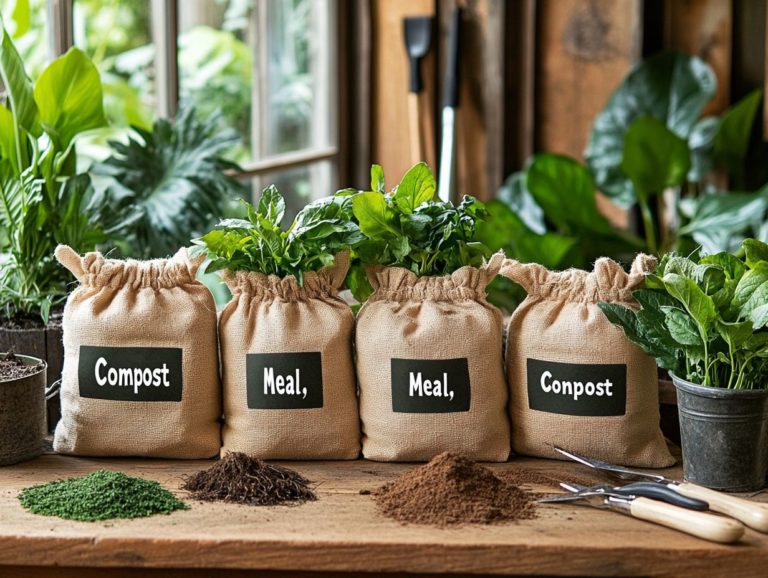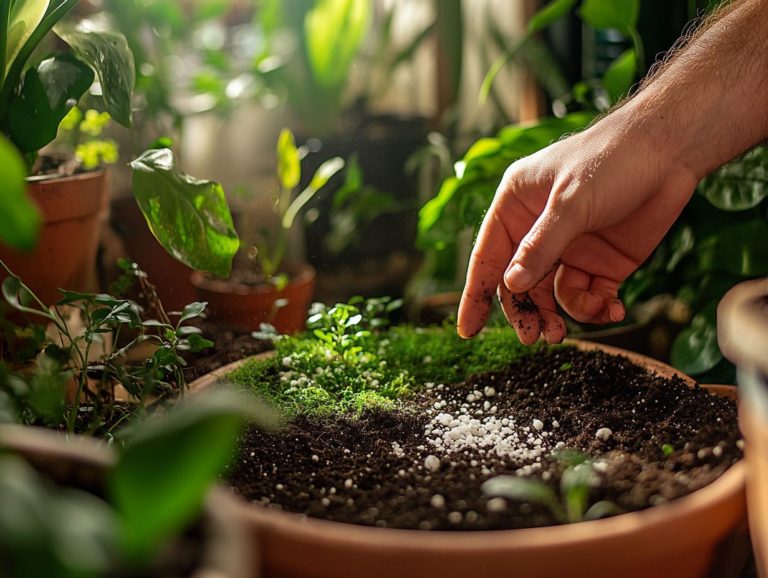The Benefits of Using Perlite in Indoor Soil
Perlite is a lightweight volcanic glass that has become a cornerstone of indoor gardening. Its unique composition offers advantages such as improved drainage, aeration, and enhanced nutrient retention.
In this article, you will explore what perlite is and how it can transform your potting mix. Discover practical methods for incorporating perlite into your indoor soil, along with additional benefits like reducing soil compaction and preventing overwatering, especially in container gardening.
Whether you re a seasoned gardener or just beginning your journey, dive into the world of perlite now and watch your plants soar to new heights!
Contents
- Key Takeaways:
- What is Perlite?
- Advantages of Using Perlite in Indoor Soil
- How to Use Perlite in Indoor Soil
- Other Benefits of Perlite for Indoor Plants
- Frequently Asked Questions
- Unlock the Power of Perlite: Why Your Plants Love It!
- How Does Perlite Improve Air Flow in Indoor Soil?
- Does Perlite Also Aid in Drainage for Indoor Plants?
- Can Adding Perlite to Indoor Soil Help with Moisture Retention?
- Is Perlite Safe to Use in Indoor Soil for All Types of Plants?
- How Much Perlite Should I Add to My Indoor Soil?
Key Takeaways:
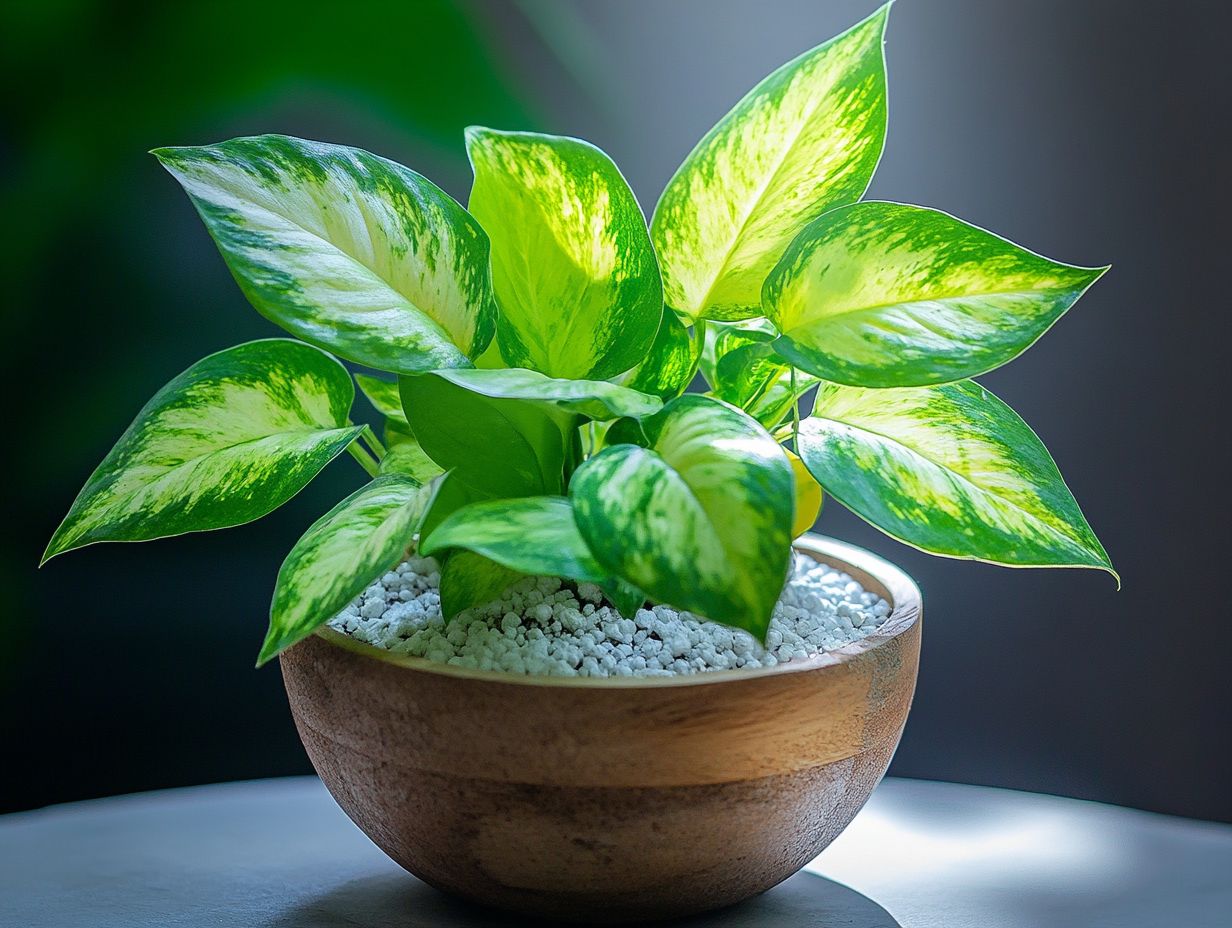
- Perlite boosts drainage and aeration in your soil, ensuring healthy roots and happy plants!
- When incorporated into potting mix or used as a top dressing, perlite enhances nutrient retention, providing essential minerals for optimal plant growth.
- Perlite also reduces the risk of soil compaction and overwatering, making it a versatile addition to any indoor gardening routine.
What is Perlite?
Perlite is a lightweight, granular substance derived from volcanic glass, and it s becoming a favorite in gardening and various industrial applications. This amazing quality makes perlite a must-have for all your gardening projects!
This distinctive material is produced through a rapid expansion process, where raw volcanic glass is heated, transforming it into expanded perlite that is non-toxic and doesn t alter the acidity of the soil.
Its exceptional properties make it an invaluable soil amendment, particularly in organic gardening. It improves soil structure and aeration, creating an ideal environment for plant roots to thrive.
Definition and Composition
Perlite is a fascinating, lightweight material derived from volcanic glass, transformed through a high-temperature expansion process into the expanded perlite that s often found in gardening.
This transformation involves heating the raw perlite to temperatures that soar beyond 1,600 degrees Fahrenheit. The moisture trapped within the volcanic glass vaporizes, causing the material to expand dramatically. The end product is a pH-neutral substrate that excels in aeration and drainage, ensuring it won t leach harmful chemicals into the soil.
This quality makes it particularly advantageous for various gardening applications, such as potting mixes and hydroponic systems. By incorporating perlite, you can effectively maintain the ideal balance of nutrients and moisture, ultimately fostering robust plant growth.
Advantages of Using Perlite in Indoor Soil
Incorporating perlite into your indoor soil brings a host of benefits. Its lightweight quality significantly enhances drainage and aeration both vital for thriving plant growth.
When you add perlite, you improve the soil structure, creating air pockets that encourage robust root development while retaining moisture effectively. This balance is essential for successful container gardening and plant propagation.
Improved Drainage and Aeration
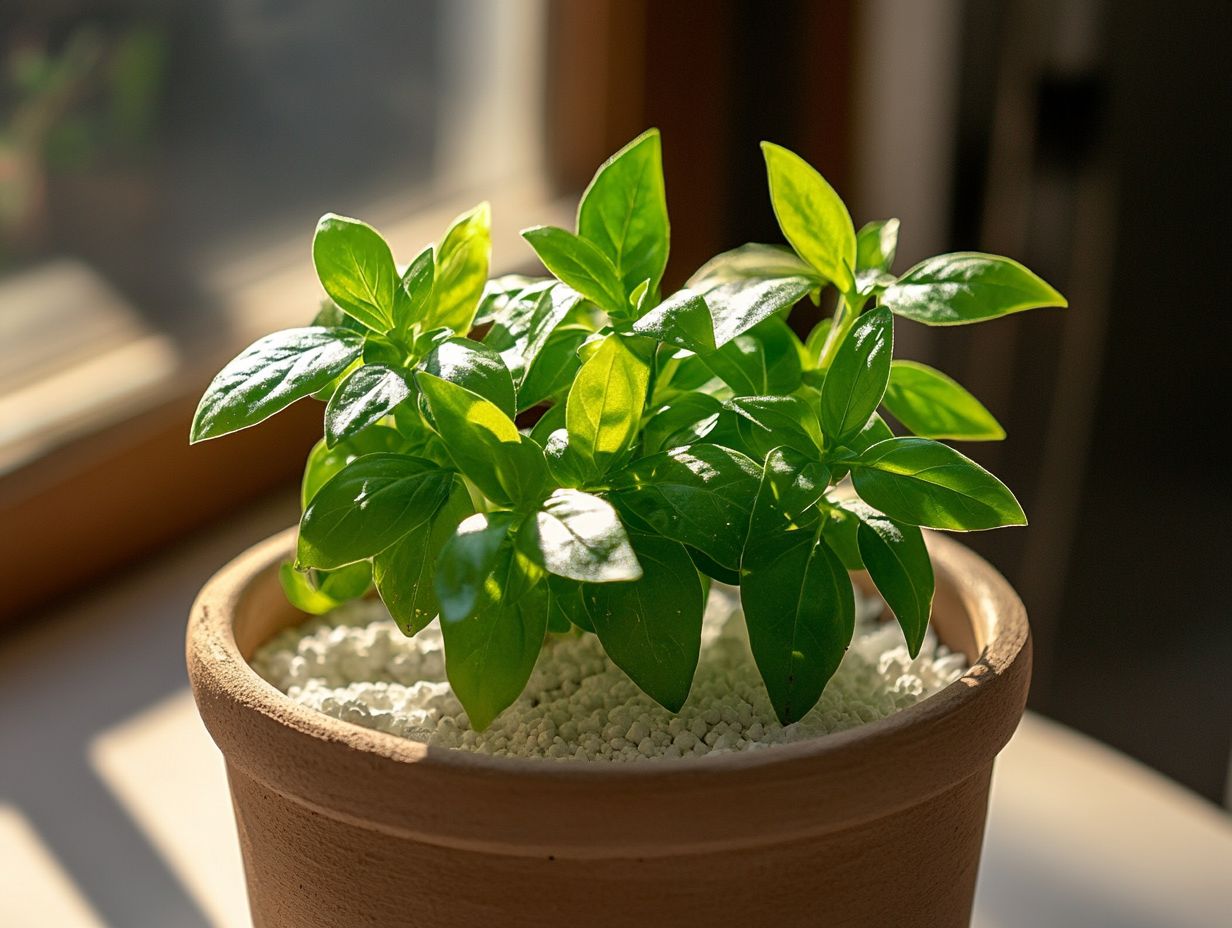
Incorporating perlite into your potting mixes enhances drainage and aeration. This allows excess water to flow away while creating essential air pockets for healthy root development.
This enhancement is vital for preventing waterlogging, which can lead to root rot and other harmful conditions for your plants. When you mix perlite into the soil, it acts as a lightweight, porous aggregate that fosters optimal conditions for various root systems.
For instance, succulent varieties like echeveria and jade plants truly thrive in soils amended with perlite, as they need well-drained environments to flourish.
Herbs such as basil and thyme also reap significant benefits from these mixes; the improved aeration encourages robust growth and vitality.
Ultimately, adding perlite can be a game changer for anyone from novice to experienced gardeners looking to cultivate healthy, thriving plant life.
Enhanced Nutrient Retention
Perlite does more than just facilitate drainage; it enhances nutrient retention. This creates an ideal environment where moisture and nutrients combine to support vibrant plant growth.
Perlite is a remarkable volcanic glass. When incorporated into your soil, it generates air pockets that significantly improve aeration while preventing compaction. As a result, crucial nutrients remain accessible, avoiding rapid leaching and establishing a stable foundation for your root systems to flourish.
As a superior soil amendment, perlite harmonizes beautifully with other materials. It optimizes the balance of organic matter and minerals essential for gardening success. With enhanced nutrient storage, your plants gain access to vital elements, leading to healthier foliage and more robust flowering transforming your garden into a thriving, lush paradise.
How to Use Perlite in Indoor Soil
Incorporating perlite into your indoor soil is a simple yet effective process. You can easily mix perlite into your potting mixes or use it as a top dressing.
This transforms your plant propagation game and ensures your greenery flourishes beautifully.
Incorporating Perlite into Potting Mix
To elevate your potting mix, incorporating perlite is a straightforward strategy. A recommended approach is to use a ratio of 1 part perlite to 3 parts potting soil to optimize both drainage and aeration.
For succulent and cactus potting mixes, you might want to adjust that ratio to 1 part perlite to 2 parts soil. These resilient plants thrive in drier conditions. Conversely, if you re tending to moisture-loving plants like ferns, consider a 1:4 ratio of perlite to potting soil. This balance helps maintain adequate moisture while still encouraging airflow.
As you mix, be sure to distribute the perlite evenly throughout the soil. This enhances the overall structure and prevents compaction over time. By making this amendment, you significantly improve drainage and elevate the soil’s quality, creating an environment that promotes healthy root growth and effective nutrient absorption (the process by which plants take in minerals and vitamins from the soil).
Top Dressing with Perlite
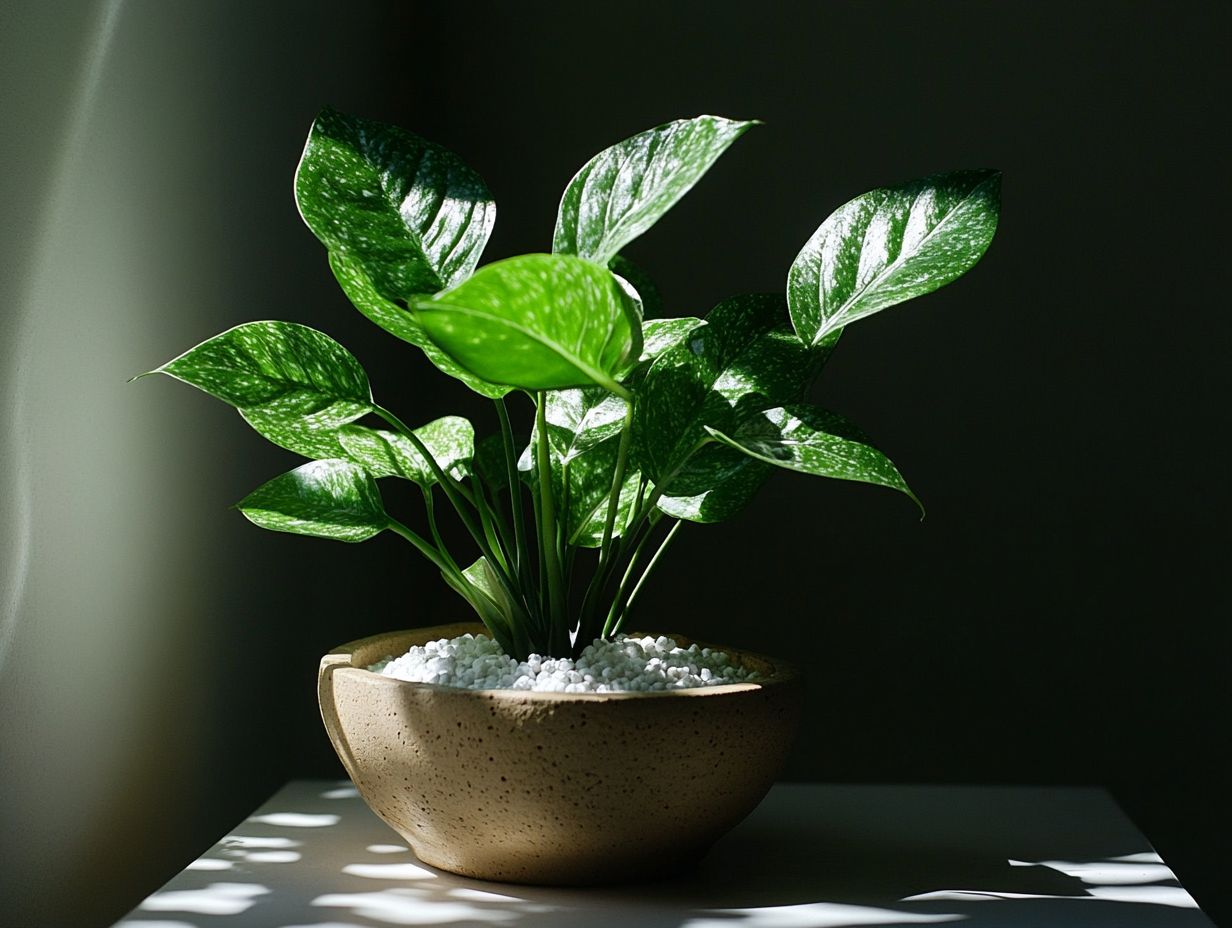
Top dressing with perlite involves spreading a layer over the soil surface in your container gardens. This method not only enhances moisture retention but also promotes aeration.
This technique is particularly beneficial for your potted plants, as it reduces the frequency of watering while creating a well-aerated root environment. When applied effectively, perlite can significantly boost the vitality of your plants, resulting in lush growth and vibrant foliage.
For example, if you’re a succulent enthusiast, you’ll find perlite invaluable as a top dressing. It helps prevent soil compaction and ensures healthy drainage essential for these moisture-sensitive species. By incorporating perlite in this way, you can achieve better temperature regulation in your pots, keeping roots cool in warmer climates and ultimately enhancing their health and resilience.
Other Benefits of Perlite for Indoor Plants
Beyond its impressive moisture retention and nutrient benefits, perlite presents remarkable advantages that you won’t want to overlook.
It significantly reduces the risk of soil compaction, a vital factor in preventing overwatering and root rot in your indoor plants. This makes it an essential addition to your gardening toolkit.
Reduced Risk of Soil Compaction
Perlite significantly mitigates the risk of soil compaction and cultivates a more airy soil that enables your plant roots to spread and grow efficiently.
This enhanced aeration is vital for healthy plant development. It facilitates improved water retention, nutrient absorption, and gas exchange within the soil. For instance, vegetables such as tomatoes and peppers flourish when planted in a mix that incorporates perlite, as it helps prevent root rot caused by tightly compacted soil.
In your gardening practices, consider adding a layer of perlite when potting your indoor plants. This simple step can enhance drainage and diminish the risk of moisture-related diseases. It s particularly beneficial for varieties like succulents and ferns, which thrive in lighter soil structures for optimal growth.
Preventing Overwatering and Root Rot
By enhancing drainage and moisture balance, perlite plays a crucial role in preventing overwatering and root rot two common challenges in indoor gardening.
This lightweight volcanic glass creates air pockets within the soil, allowing excess water to escape while retaining just the right amount of moisture for your plant’s roots to flourish. For indoor gardeners like yourself, maintaining optimal moisture levels is essential. Too much water can lead to saturated soil, ultimately suffocating the roots.
Incorporating perlite into your potting mix improves drainage. It also promotes healthier root development, significantly reducing the risk of fungal infections and nutrient deficiencies. Striking the perfect balance of aeration and moisture with perlite can profoundly enhance your plant’s vitality. This leads to increased longevity for your plants.
Frequently Asked Questions
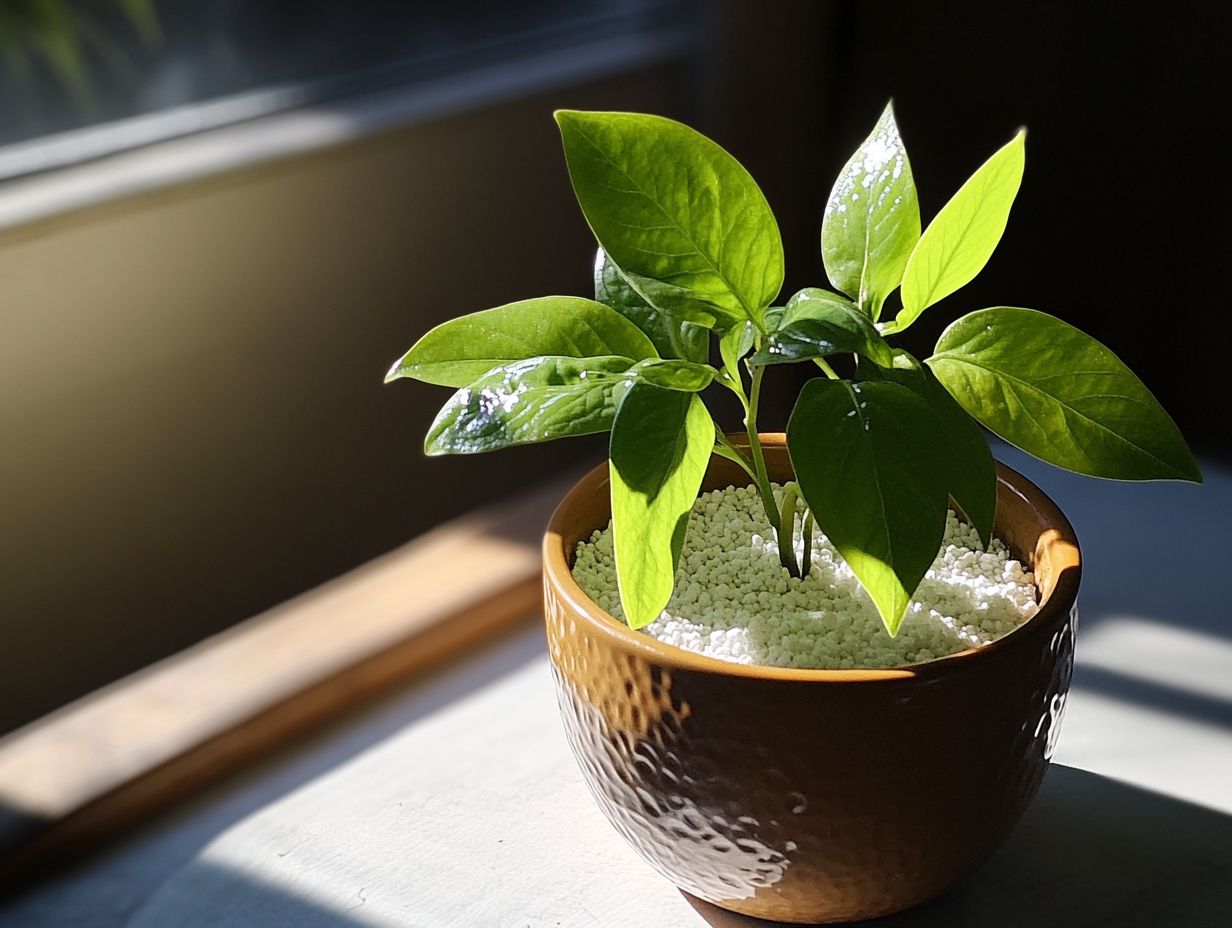
Unlock the Power of Perlite: Why Your Plants Love It!
Perlite is a natural mineral that is expanded by heating, resulting in a lightweight and porous material. Adding perlite to indoor soil helps with air flow, drainage, and moisture retention.
How Does Perlite Improve Air Flow in Indoor Soil?
Perlite has small cavities on its surface that allow for air pockets in the soil, promoting better circulation and oxygen flow to plant roots. This is especially important in compacted or dense soils.
Does Perlite Also Aid in Drainage for Indoor Plants?
Yes, perlite is a highly porous material that helps excess water drain more efficiently from the soil. This prevents waterlogging and root rot, which are common issues in indoor plants.
Can Adding Perlite to Indoor Soil Help with Moisture Retention?
Absolutely! Perlite eagerly absorbs moisture and releases it back slowly, keeping your plants happy and healthy. This is beneficial for plants that require consistent levels of moisture, as perlite helps to prevent the soil from drying out too quickly.
Is Perlite Safe to Use in Indoor Soil for All Types of Plants?
Yes, perlite is a natural and non-toxic material, making it safe to use for all types of indoor plants. It is also chemically inert, so it will not affect the pH levels of your soil.
How Much Perlite Should I Add to My Indoor Soil?
The recommended ratio of perlite to soil can vary, but a general rule of thumb is to add 10-30% perlite to your soil mixture. This can be adjusted based on the specific needs of your plants and the type of soil you are using.

